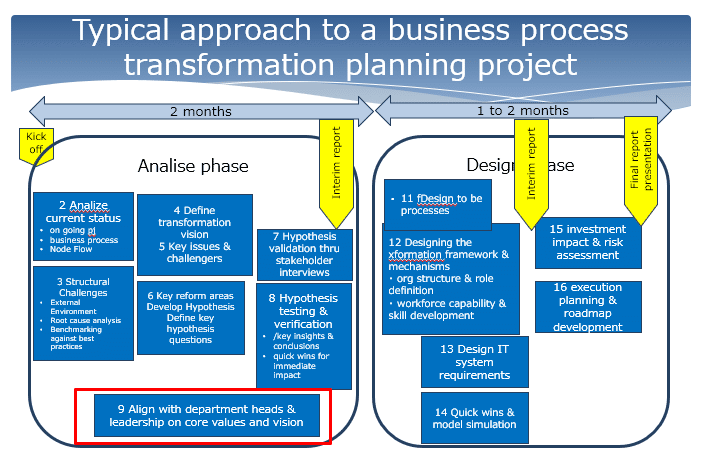
How to Develop a DX Plan in Three Months Part 5: Aligning Values Across Leadership🌹
Digital Transformation (DX) refers to the fundamental transformation of business models and operational processes through digital technology.
For example, UNIQLO has implemented an omnichannel strategy, seamlessly integrating physical stores with its online platform. Customers can order online and pick up their items at a nearby store.
Additionally, the company has digitized its inventory management system, enabling real-time visibility into stock availability across locations. This minimizes excess inventory while enhancing the customer experience.
In this article, we focus on a critical aspect of the "How to Build a DX Plan in Three Months" framework:
"Aligning Values Across Department Leaders." 🎈
⏩ What Is a Business Transformation Strategy?
Imagine a company facing the following challenges:
Increasing competition threatening market position
Declining customer orders
A stagnating flagship product
To address these issues, companies must rethink their corporate structure, processes, and business operations. This strategic overhaul, aimed at reshaping organizational efficiency and long-term sustainability, is what we define as a Business Transformation Strategy.
Below is a sample three-month transformation project timeline. This article specifically focuses on a key phase: how to align values among department leaders based on insights from the analysis phase.

⏩ 🎈 What Does Aligning Values Across Leadership Mean?
Now, consider this scenario:
If you were a Head of Production, Procurement, or Sales, how would you react if you were suddenly called into a two-hour meeting and told:
"We’ve developed a transformation plan. Let us explain it to you."
During this session, you'd be presented with:
✅ Current State Analysis
✅ Root Causes of Structural Issues
✅ Vision, Primary & Secondary Challenges, and Reform Hypotheses
✅ Preliminary Feedback Interviews
✅ Validation of Assumptions
Would you enthusiastically agree and say, "Yes! Let’s do it!"?
For most department leaders to truly commit ("This is my plan"), the following conditions must be met:
✅ Their input is incorporated into the plan.
✅ Their department’s pain points are acknowledged.
✅ They gain fresh insights from other departments or customer perspectives.
✅ They clearly understand why they must change and find the logic behind it compelling.
Aligning values is about creating these conditions through consistent and structured communication.
Rather than presenting a two-hour final report at the end of the analysis phase, leaders must be actively engaged in each step of the analysis process. The key is to involve them in shaping conclusions, rather than simply informing them of the results.
By doing so, they don’t just accept the transformation plan—they own it. This fosters commitment, where each leader sees the initiative as their own, driving it forward with conviction.
⏩ Engaging Leadership in Decision-Making Throughout the Analysis Phase
Below are the five key steps in the analysis phase and their respective deliverables:
✅ Current State Analysis – Mapping existing processes, such as the supply chain from order to delivery, to identify inefficiencies as below.
■ Node Flow:
Represents the end-to-end physical movement of parts and products, from suppliers to customers. This flowchart provides a comprehensive view of material movement across the entire supply chain.
■ Lead Time Structure:
Illustrates the time dynamics of the supply chain, mapping how long-lead-time components are procured based on market demand forecasts, ensuring that finished products can be delivered promptly upon customer orders.
■ Business Process Flow:
Depicts the functional workflow from order intake to final delivery, detailing the responsibilities of each department over time. This enables a clear understanding of how cross-functional activities align to fulfill customer demand.
✅ Root Cause Analysis – Facilitating cross-functional discussions among department leaders to uncover structural issues.
When driving a supply chain transformation aimed at improving product delivery to customers, it is essential to systematically identify and document inefficiencies. The following five critical dimensions serve as a structured framework for problem identification:
■ Excessive Lead Time – The overall time required to deliver products to customers is too long, leading to delayed fulfillment and reduced competitiveness.
■ High Total Inventory Levels – Excess stock across various stages, including raw materials, finished goods, and distribution inventory, ties up capital and increases holding costs.
■ Rising Logistics Costs – Escalating transportation and warehousing expenses reduce margin efficiency and put financial strain on operations.
■ Declining Customer Service Levels – Delivery delays, order fulfillment issues, and supply inconsistencies negatively impact customer satisfaction and retention.
■ Lack of Agility in Response to Change – The supply chain struggles to adapt to fluctuations in demand, disruptions, or shifts in market conditions, resulting in inefficiencies and missed opportunities.
✅ Defining Key Transformation Hypotheses – Establishing a Vision and forming hypotheses on "What to change" and "How to change it".
■ Vision Development
The project team collaboratively defines the desired future state, articulating it in clear, concise language that serves as a guiding principle for transformation.
■ Identifying Primary Challenges (What?)
To achieve the Vision, the team systematically identifies key challenges that must be addressed. Typically, around ten critical issues emerge that form the foundation of the transformation roadmap.
■ Formulating Hypotheses for Execution (How?)
For each primary challenge, the team develops hypothetical solutions by defining the required changes. This process follows an As-Is → To-Be framework:
■ Current State (As-Is): The existing approach or process.
■ Future State (To-Be): The proposed change necessary to achieve the identified challenges.
✅ Hypothesis Testing – Conducting interviews with internal stakeholders and external partners (customers, suppliers) to validate assumptions.
✅ Validation & Finalization – Consolidating feedback, refining the strategy, and aligning leadership on the transformation direction.
When conducting hypothesis interviews and validation, the following structured process is used to systematically organize and assess information:
■ Fact Verification – Was the Hypothesis Correct?
Did the interviewees confirm the hypothesis as accurate?
Were we able to obtain factual data supporting its validity?
If the hypothesis was incorrect, did we collect factual evidence that contradicts it?
■ Key Findings – What Insights Emerged?
The gathered data is analyzed and discussed within the project team.
Through this process, new insights and discoveries naturally emerge, often revealing underlying issues or alternative perspectives.
■ Conclusion – What Should Be Transformed?
Based on the findings, we determine what needs to be changed and how.
The rationale behind the conclusion is structured with supporting facts and key discoveries.
■ Recommendation – Framing the Transformation Plan
The final recommendation is presented to senior leadership with a clear timeline, specifying:
✅What changes should be made
✅How they should be executed
✅By when they should be completed
✅Additionally, any critical support needed from top leadership is clearly outlined.

By the end of these five steps, the company will have gathered comprehensive, validated insights necessary for transformation.
However, the real value lies not just in the insights themselves, but in the involvement of department leaders throughout the process.
Their participation ensures that:
Key reform decisions are based on collective discussions.
The rationale for transformation is clearly communicated.
The entire leadership team shares ownership of the transformation agenda.
⏩ How to Effectively Align Leadership?
Simply presenting a plan in a one-time meeting is ineffective.
People rarely "buy in" to ideas they had no role in shaping.
Instead, leadership should be actively involved throughout the five-step analysis phase.
When department leaders participate in key decision-making points, they feel:
✅ Their perspectives are valued.
✅ The plan reflects their department’s reality.
✅ They have a personal stake in the initiative’s success.
This approach is a core principle of Change Management, which increases the likelihood of successful transformation. By ensuring leadership involvement, organizations build a strong foundation for execution.
⏩Summary
This article has covered a critical element of business transformation: Aligning Values Across Leadership.

Many professionals in corporate environments will, at some point, find themselves leading or contributing to organizational change initiatives—whether to enhance customer satisfaction, improve operational efficiency, or drive innovation.
Perhaps you are already questioning your company’s status quo and considering ways to drive meaningful change.
In such cases, the structured engagement of department leaders—as outlined in this article—will prove invaluable.
Key Takeaway:
At the start of any transformation project, ensure department leaders are not merely informed but are actively engaged in shaping decisions. Their commitment is the catalyst for successful change. 😊
この記事が気に入ったらチップで応援してみませんか?

